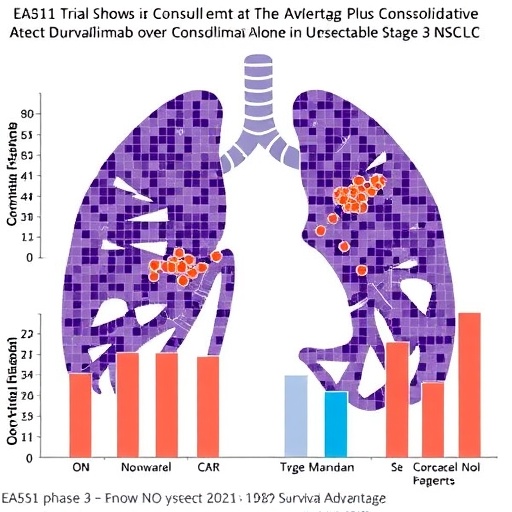(Barcelona, Spain – September 8, 2025, 10:45 a.m. CEST / UTC +2) — In a pivotal development presented at the International Association for the Study of Lung Cancer (IASLC) 2025 World Conference on Lung Cancer (WCLC), new findings from the Phase 3 EA5181 clinical trial challenge current hypotheses regarding the timing of durvalumab administration in the management of unresectable stage III non-small cell lung cancer (NSCLC). Contrary to expectations, initiating durvalumab concurrently with chemoradiotherapy (CRT), followed by durvalumab consolidation, failed to demonstrate a survival advantage over the existing standard of consolidation durvalumab alone post-CRT.
Durvalumab, an immune checkpoint inhibitor targeting the PD-L1 pathway, has transformed the treatment landscape for unresectable stage III NSCLC patients by significantly extending overall survival (OS) when deployed as consolidation therapy after definitive CRT. This immunotherapeutic agent reactivates T-cell antitumor activity by blocking inhibitory signals, thereby enhancing the clearance of residual cancer cells post-radiation and chemotherapy. However, the optimal sequencing and timing of durvalumab—whether concurrent with CRT or exclusively as consolidation—has remained an open question until this large-scale randomized investigation.
The EA5181 trial enrolled 662 patients with previously untreated, unresectable stage IIIA to IIIC NSCLC, or those experiencing mediastinal nodal recurrence following surgery. Participants were randomized into two arms: Arm A received durvalumab concurrently with platinum-based chemotherapy and radiotherapy, succeeded by a year of durvalumab consolidation; in Arm B, patients underwent standard CRT alone followed by durvalumab consolidation if no progression or severe toxicity occurred. This rigorous design allowed for a robust comparison of the impact of concurrent administration versus the conventional consolidation approach.
After comprehensive follow-up, results indicated no statistically significant improvement in median overall survival between both study cohorts. Arm A reported a median OS of 41.5 months compared to 39.4 months in Arm B (p=0.83; hazard ratio [HR]=1.03), indicating that concurrent durvalumab does not confer added survival benefit. Moreover, median progression-free survival (PFS) was slightly shorter in the concurrent arm (15.5 months) compared to consolidation alone (16.8 months), but this difference lacked statistical significance (p=0.65; HR=1.05). Objective response rates, patterns of failure—including locoregional and distant recurrences—and safety profiles were comparable across the two groups.
These findings critically inform the clinical management of stage III NSCLC by underscoring that the strategic timing of immunotherapy initiation is paramount, with immediate concurrent administration during CRT offering no discernible advantage over starting durvalumab once CRT is complete. This aligns with established practice guidelines that advocate for the sequential introduction of immune checkpoint inhibitors post-CRT, reaffirming their continued applicability based on emerging evidence.
John Varlotto, M.D., of Marshall University, who presented the study, emphasized the significance of these results: “Our data demonstrate that adding durvalumab concurrently with chemoradiotherapy does not improve overall survival compared to the current approach of initiating durvalumab as consolidation therapy. These results support maintaining the present standard in treating unresectable stage III NSCLC.” His remarks highlight the critical role of evidence-based therapeutic sequencing and dispel prior assumptions regarding potential synergistic benefits of concurrent immunotherapy.
Beyond the principal outcomes, exploratory analyses revealed that certain clinical and biological factors correlated with enhanced patient prognosis. Specifically, patients with an Eastern Cooperative Oncology Group (ECOG) performance status indicative of better baseline functional capacity, those harboring adenocarcinoma histology, and individuals possessing a diffusing capacity of the lung for carbon monoxide (DLCO) greater than 80% exhibited significantly improved survival metrics. Intriguingly, a history of prior thoracic surgery was associated with superior progression-free survival, suggesting possible prognostic implications of disease biology and treatment history on therapeutic responsiveness.
The immunological rationale for attempting concurrent durvalumab is grounded in the concept that CRT induces immunogenic cell death, potentially augmenting antigen presentation and T-cell priming, thereby enhancing the efficacy of checkpoint blockade. Despite this theoretical synergy, the trial’s outcomes indicate that the concurrent approach may not translate into clinical benefit, possibly due to increased toxicity, immune exhaustion, or timing mismatches in the host immune response.
Toxicity profiles were meticulously monitored throughout the trial, with findings indicating no significant increase in severe adverse events in the concurrent treatment group. This suggests that while safety concerns did not limit durvalumab administration during CRT, the lack of survival benefit cannot be attributed to prohibitive toxicity but more likely reflects intrinsic biological interactions.
As the IASLC continues to facilitate the dissemination of cutting-edge research, the EA5181 trial exemplifies the importance of large, methodically sound randomized studies to refine lung cancer treatment paradigms. Lung cancer remains the leading cause of cancer mortality globally, and advancements in staging, radiotherapy techniques, chemotherapy regimens, and immunotherapy have collaboratively improved patient outcomes. Nonetheless, optimizing therapeutic sequences remains a critical frontier.
The findings prompt further investigations into mechanisms governing response and resistance to immunotherapy in stage III NSCLC, including exploring biomarkers that predict durability of treatment effect and potential combinatorial approaches with novel agents. Additionally, the role of personalized treatment plans adapted to patient-specific tumor genomics, immune microenvironment characteristics, and functional status must be scrutinized to enhance precision oncology.
This trial’s data, unveiled at the largest international forum dedicated to thoracic malignancies, reinforce the necessity of robust, evidence-based treatment guidelines and support the ongoing use of durvalumab consolidation post-CRT as the standard of care. Investigators and clinicians are encouraged to integrate these findings into practice, ensuring optimal sequencing of immunotherapy to maximize patient survival without unnecessary treatment escalation.
In conclusion, the EA5181 trial’s comprehensive investigation into durvalumab timing in unresectable stage III NSCLC reveals no advantage for concurrent administration with chemoradiotherapy. These insights refine our therapeutic approach to one of the most challenging lung cancer subsets, guiding future research and clinical decision-making with high-level evidence toward improving survival outcomes in this complex disease.
Subject of Research: Treatment sequencing of durvalumab in unresectable stage III non-small cell lung cancer (NSCLC)
Article Title: Concurrent Durvalumab with Chemoradiotherapy Fails to Improve Survival Over Consolidation Alone in Stage III NSCLC: Results from the Phase 3 EA5181 Trial
News Publication Date: September 8, 2025
Web References:
International Association for the Study of Lung Cancer (IASLC): www.iaslc.org
Journal of Thoracic Oncology
Keywords: Lung cancer, non-small cell lung cancer, durvalumab, chemoradiotherapy, immune checkpoint inhibitors, consolidation therapy, stage III NSCLC, overall survival, progression-free survival, immunotherapy sequencing, EA5181 trial
Tags: cancer treatment advancementschemoradiotherapy and immunotherapyconcurrent versus consolidation therapydurvalumab treatment sequencingEA5181 clinical trialIASLC World Conference on Lung Cancerimmune checkpoint inhibitorslarge-scale randomized investigationnon-small cell lung cancer managementoverall survival in lung cancerPD-L1 pathway inhibitionunresectable stage III NSCLC





